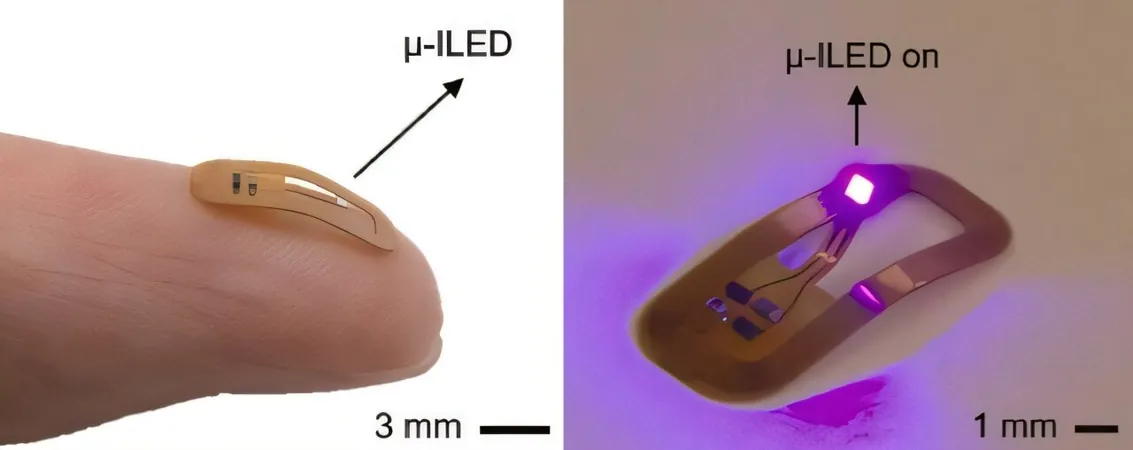
Revolutionary Wireless Device Transforms Pain Management with Light-Activated Drugs
2025-05-08
Author: Li
A Breakthrough in Pain Relief Technology
Imagine a world where pain relief is activated not by popping pills, but through a simple beam of light! Scientists have recently unveiled a groundbreaking wireless device that precisely activates light-sensitive pain medications, promising a new era for treating conditions without the downsides of traditional opioids.
Harnessing the Power of Photopharmacology
This pioneering device enables the remote activation of a photosensitive drug derived from morphine, renowned for its powerful analgesic properties. In a recent animal study, this innovative approach demonstrated promising results in targeting pain relief where it's needed most, all while avoiding the dangerous side effects typically associated with opioid use.
How Does It Work?
The mechanism is fascinating: the team utilized a modified form of morphine called photo-caged morphine (pc-Mor), which remains inactive until exposed to a specific wavelength of light (405 nanometers). This method allows for targeted delivery of the medication directly to affected tissues, ensuring precise treatment without the burden of narcotic side effects.
Efficacy Without the Risks
Research findings indicate that the analgesic effect of the locally released morphine matches that of conventional administration while entirely sidestepping issues like addiction, tolerance, and constipation. Francisco Ciruela, the lead researcher from the University of Barcelona, highlighted the importance of this innovation in combating the opioid crisis.
A Technological Marvel
The device itself is miniaturized to just a few millimeters, featuring a microLED to activate morphine in the spinal cord. It’s equipped with a mini radiofrequency antenna that harnesses wireless power via NFC technology, making it easily programmable for optimal treatment specificity. This technology liberates patients from the constraints of traditional drug delivery methods.
Potential for Broader Applications
The implications of this development extend far beyond pain management. This wireless photopharmacology technique could revolutionize treatments for chronic conditions like epilepsy, Parkinson’s disease, and even certain psychological disorders, allowing for localized drug activation to minimize systemic side effects.
Future Horizons: Tackling Cancer and More
In the realm of oncology, this technology could enable precise photoactivation of chemotherapeutics directly within tumors, leading to a more concentrated attack on cancer cells while reducing adverse effects elsewhere in the body. The path forward may be filled with challenges, such as ensuring the safety and efficiency of these innovative treatments, but the promise they hold is undeniable.
Conclusion: A New Dawn for Pain Management
As research in this dynamic field progresses, the future looks bright for wireless photopharmacology. With its ability to deliver effective, personalized treatments without the risks of traditional opioids, this technology may soon change the landscape of pain management forever.





 Brasil (PT)
Brasil (PT)
 Canada (EN)
Canada (EN)
 Chile (ES)
Chile (ES)
 Česko (CS)
Česko (CS)
 대한민국 (KO)
대한민국 (KO)
 España (ES)
España (ES)
 France (FR)
France (FR)
 Hong Kong (EN)
Hong Kong (EN)
 Italia (IT)
Italia (IT)
 日本 (JA)
日本 (JA)
 Magyarország (HU)
Magyarország (HU)
 Norge (NO)
Norge (NO)
 Polska (PL)
Polska (PL)
 Schweiz (DE)
Schweiz (DE)
 Singapore (EN)
Singapore (EN)
 Sverige (SV)
Sverige (SV)
 Suomi (FI)
Suomi (FI)
 Türkiye (TR)
Türkiye (TR)
 الإمارات العربية المتحدة (AR)
الإمارات العربية المتحدة (AR)